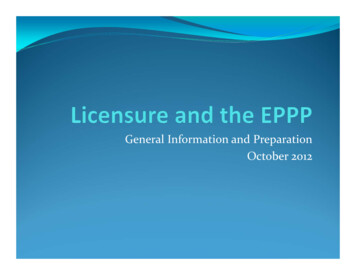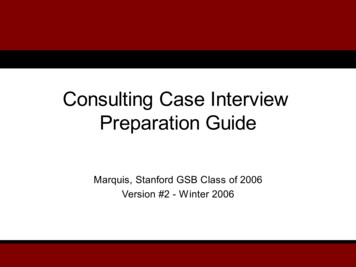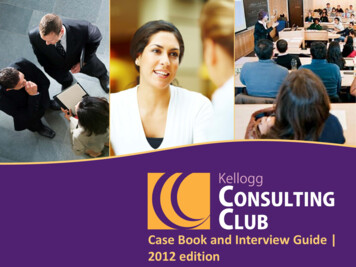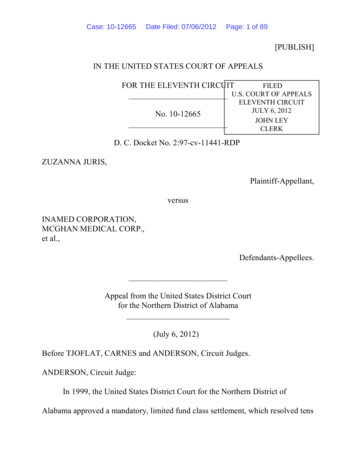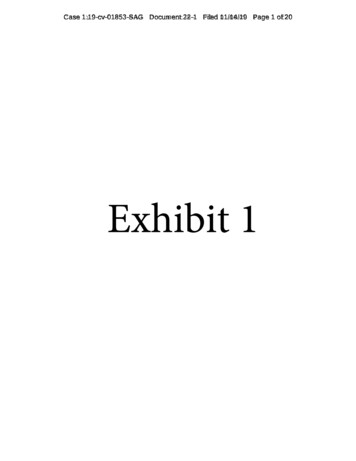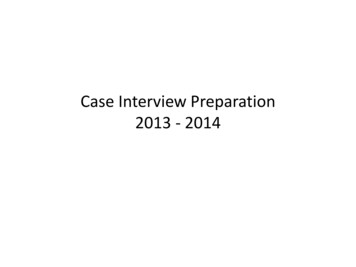
Transcription
Case Interview Preparation2013 - 2014
Welcome to the MCA!Our goal is to provide you with the resources and support to ace the consulting interview process. But this book is justone part of that. You’ll build the skills you need to succeed at the Case Prep Sessions we will offer throughout the fall.Each session will focus on a key component of case interviews, and those identified with an * will be followed by adedicated hour to do a practice case with your peers. We will also offer case practice weeks, where MCA executiveswill help you break down cases and answer any case prep questions you may have. The current schedule is as follows:SessionFocusDelivered ByDate1Introduction to case interviewsPromeoOctober 19-20, 20132In-depth structuring and frameworks*MCAOctober 22, 20133Case practice weekMCAOctober 29, 20134Case interview tools*MCANovember 5, 20135Case practice weekMCANovember 19, 20136Communication in case interviews*MCANovember 26, 20135Taking case interviews to the next levelPromeoDecember 7-8, 2013In between sessions, though, it’s up to you to prep as much as possible. This book gets you started with 30 of ourfavourite cases – and you’ll find many others on our website at (Password: mcaresources).FINAL TIP: It is difficult to find high quality cases – we recommend that you save these cases for mock interviews withyour peers. In other words, do not read through this book on your own, as once you have read a case, it is no longereffective as a mock interview.Looking forward to seeing you at the Case Prep sessions!
The Case List(in approximate order of difficulty)GaveRec’dGave1. Gift Wrapping Paper16. Nextel Cup – Car Racing2. Butcher Shop17. Pharmaceutical Distribution3. Travel Agency18. Book Retailer4. Cable Company19. Molds R Us5. Tissue Paper20. Juice Producer6. Sheep Auction21. Airline Broadband7. Insurance Provider22. Auto Manufacturer8. Luxury Car Maker23. Business School Journal9. Appliance Insurance24. Sandwich Bags10. Charcuterie Processor25. School Buses11. Multipurpose Tool26. Retail Discounting12. HVAC Service Provider27. La Seine Soft Drinks13. Upscale Restaurant28. Electronics Retailer14. Frozen Dough29. Trucking15. Software Product30. Hong Kong PortRec’d
Additional Cases & Suggested nized by ex-McKinsey consultantVictor Cheng, caseinterview.comprovides access to: Daily emails with interview tips Look Over My Shoulder audiosand videos of actual candidatesbeing reviewed while they gothrough a case interview Access to online math drillsBooks:Case Interview Secretsby Victor ChengCase and Pointby Marc ConstentinoCrack the Caseby David OhrvallReleased in 2012, it’s an updated andmore robust version of thecaseinterview.com website. Providesdetails on the different case interviewstyles and tips for excelingA well organized book that walksthrough the full consulting interviewprocess from research on the firms, tomath drills, and skills to showcase duringboth your case and behaviouralinterviews.The latest version provides sampleframeworks, 43 cases, and 150 videos tohelp prepare you for the interviewprocess.
Overview of Key Concepts
General Framework: ProfitabilityTopicAreaRevenueRevenueCostsCostsKey DriversVolumeKey Drivers Internal Price, Customer Service, Distribution/Inventory/Capacity Volume(Affected by: Price, CustomerService,Substitutes/Complements,Market External Competition,Distribution/Inventory/Capacity, Demand,Forces/DemandCompetition, Substitutes, Market Forces)PriceCompetition, Elasticity, Differentiation, Segments Price (Affected by: Competition, Elasticity,Product MixDifferentiation, Segments/Price Discrimination) Product Mix FixedCosts (Affectedby: Overhead,Fixed CostsManufacturing,Marketing,Overhead,IT, SG&A,Marketing,PP&E IT,SG&A,PP&E) Maintenance, Packaging,Variable CostsInputs, Labor,Distribution, Variable Costs (Affected by: Inputs, Labour,InventoryDistribution, Maintenance, Packaging)Balance Sheet Items OtherAccounting/Capacityconsiderations that couldaffect costs:Benchmark Opportunity Cost/CostUtilizationAccounting (allocations), foreign exchange,regulations- 12 -
General Framework: Business SituationTopicKey DriversCustomersMarket SizeSegmentsNeedsPurchase DriversPrice ElasticityRetention/LoyaltyProductNature (benefits, why someone would use it)Commodity vs. ngCompanyCapabilitiesDistribution channelsCost structure (mainly fixed vs. variable)Intangibles (brand)Organizational structure/incentivesCompetitionConcentration and structureBest practicesBarriers to entryPotential reactions
General Framework: Value Chain
Marketing Concepts: 4 P’s4 P’sConsiderationsProductFeatures and capabilitiesQuality and reputationService and warrantiesPackaging and sizePositioning and market segmentationPromotionConsumer awarenessLoyaltyAdvertising mediumBuying processTrial/repurchasePricePerceived valueWillingness to payRetail/discountsEconomic incentivesSkimmingPlace ion
Marketing Concepts: 3 C’s3 ortunities/ThreatsStrategy and visionAvailable resources/capacityExperience/Learning curveCultureCompetitionIndustrySize/Number/Market ShareEconomies of rPerceptionsLoyaltySwitching CostsPurchase BehaviourSegmentationMarket characteristics/trends
Economics ReviewConceptDefinitionAdverse SelectionSituation in which an individual’s demand for insurance is aligned to theirrisk of loss (i.e. people with the highest expected value will buyinsurance) and the insurer cannot account for this correlation in the price Restrict choice Equalize information SignalingConsumer SurplusEconomic gain achieved when consumers purchase a product for a priceless than their willingness to pay Consumer Surplus Willingness to Pay - PriceEconomies of ScaleThe average cost per unit for a business entity is reduced by increasing thescale of production.Economies of ScopeThe average cost for a business entity is reduced by producing two ormore productsElasticity InsuranceForm of risk management used to hedge against the risk of a loss in whichthe cost is equal to expected loss.Law of DiminishingReturnsAt some point in the production process, the addition of one more unit ofoutput , while holding everything else constant, will eventually lead to adecrease in per unit returns.Marginal CostCost of one more unit of output.If E 1, decrease price to increase revenueIf E 1, decreased price leads to lower revenue- 17 -
Economics ReviewConceptDefinitionMonopolyEntity is the only supplier of a particular good. Lack of competitionproduce less and charge more Barriers may include government regulation, networks, patents, etc. Revenue is the midpoint of the demand curveMoral HazardThe unobservable actions and risks that humans may take once a contract is signedsince they don’t bear consequences. It is a special case of information asymmetrythat affects the cost of transaction.OligopolyMarket is dominated by a small number of sellers. Dominant strategy is always better Sequential games - commitments helpPerfect Competition Price DiscriminationSituation in which identical goods are sold at different prices from the same provider. Ist degreeDifferent price for different willingness to pay 2nd degreeDifferent price for different quantities 3rd degreeDifferent price for different segments (attributes)Risk AverseIndividuals who prefer certainty over the uncertain for the same expected value (EV).Risk NeutralIndividuals who are indifferent on risk taking if the EV is the same.Risk SeekingIndividuals who prefer risk even if the EV for a certain event and the risk is the same.Firms take priceMR PMaximum profit MR MCP AVCshut down- 18 -
The Cases
Case 1: Gift Wrapping Paper (I of III)BCGProblem Statement NarrativeYour client is a gift wrapping paper manufacturer inthe US. They are considering a proposal tooutsource their manufacturing to mainland China.You have been called in to assist in the go/no-godecision making process. They would like to knowyour thoughts and recommendation.STEP 1: Ask the candidate to begin by establishingcost buckets.STEP 2: After cost buckets are established, askhow they may differ in China (A: Lower laborcosts )STEP 3: Let the candidate steer the interview fromhere Guidance for the Interviewer providedupon requestCost comparison provided on candidate handoutslide. Do not provide until candidate outlinespotential differences and asks for specifics betweenoptions.Fixed costs include: Plant & machinery (see exhibit for costs) Employees(see exhibit for costs)Variable costs include: Raw paper material 20 per ream (same forboth) Ink 100 per ream US 50 per ream in China Ink is special wrapping paper ink and anunavoidable costShipping cost from China to US is 150 per ream
Case 1: Gift Wrapping Paper (II of III)BCGExhibit 1
Case 1: Gift Wrapping Paper (III of III)BCG 100 Parts & machinesEstablish baseUS costs 100 LaborExpensive US based labor 20 PaperCommodity – difficult to lower 100 InkSpecialized productTOTAL COST : 320 100 Parts & machines (5*20) More equipment may increase repair costGeneratecomparableChina costs 50 Labor (25*2)Lower per employee, but hiring/firing costs may increase 20 PaperNo change 50 InkCloser to supplier, but still expensive 150 ShippingCompare two fullyloaded costs foroptionsGenerateRecommendation Shipping is the deal-breaker for China Lower shipping costs would increase attractiveness TOTAL COST : 370What might some alternatives be? Bulk shipments? Sheets rather than rolls? More variables to manage in China, not very labor intensive product in the US Does not look viable at this time Track ink, paper, employee costs in China to address long-term potential for move Non-examined issues: US shutdown costs
Case 2: Butcher Shop (I of III)n/aProblem StatementA fast food chain recently bough a bovinemeat processing outlet to supply it with freshhamburgers and other meats. The shopprocess is:Cows Enter Meat is Processed Meat isDelivered.The manager of the butcher shop hasbrought you in to help decide whether thecows should walk or run into the meatprocessing room.Guidance for interviewer andinformation provided upon requestOnly provide the following information once asked for it. SEE NEXT PAGE
Case 2: Butcher Shop (II of III)n/aInformation provided upon requestOnly provide the following information once asked for it.Shop Capacity: Only fresh hamburger meat is processed in the shop. One cow can make 20 hamburgers Shop is open for 10 hours a day, 5 days a week Walking: 10 cows can be processed per hour given current labor Running: 25 cows can be processed per hourCosts (All costs are fixed monthly costs):(only provide this information verbally –this case tests their organizationalskills in getting lots of data verbally)Gray lines are calculations theyshould do on their own.WALKRUNOverhead 5,000 10,000Labor 1,000 2,500Total Costs 6,000 12,500Burgers / week10,00025,000Cost per Burger 0.60 0.50Fast Food Chain: 10 outlets, and the meat-processing factory serves all 10 The outlets serve a vicinity of 300K people Three competitors in each vicinity (market share of 25% each). This leaves us with 75K customers. Of those 75K, 60%are outside the target demographic which us with 30K desired customers. Given healthy food trends, only a third of thosedesired customers will come to the fast food chain on a regular basis ( 10K). Of those 10K, each will frequent the establishment 2x per week, but they’ll only buy a burger ½ the time. (Demand 10K burgers per week).
Case 2: Butcher Shop (III of III)n/aRecommendation Even though its cheaper to produce more burgers, there is no demand to support it. Have the cows walk rather than run.This meets demand and ensures fresh hamburgers.Follow up question (if there is time):Let’s say that the manager is really determined to have the cows run. Can you provide ways that they can make it economicalto have the cows run into the factory?Sample Responses (these are not the only solutions): Try to build relationships with the other fast food chains and sell the excess burger meat to them. Create a process to freeze the hamburger meat so that it can be sold in grocery stores, etc. Understand the strategic plan for the fast food parent company – if there is a plan to expand thebusiness into new vicinities, then we may need to provide more burgers
Case 3: Travel Agency (I of II)n/aProblem StatementA travel agency generates revenue bymaking a 10% commission on all of its travelbookings. Their current profit before taxes is 1M, while the industry average ranges from 2M to 3.5M. You have been brought in tohelp them understand why they are makingless than the industry average.Guidance for interviewer andinformation provided upon requestOnly provide the following information once askedfor it.Revenue per year: 10MRevenue per year (competitors): about the sameProducts: Agency only handles travel ticket bookings fortheir customersCustomers: Business traveler segment (60% of rev) Leisure traveler segment (40% of rev)Volume of transactions: Business: 300K transactions Leisure: 700K transactionsCosts: cost per transaction is 9, regardless of thecustomer
Case 3: Travel Agency (II of II)n/aCalculate the profitability of each segment per transaction .SEGMENTSHAREVOLUMETOTAL REVREV/TRANSCOST /TRANSPROFIT /TRANSGAINBusiness60%300K 6M 20.00 9.00 11.00 3.3MLeisure40%700K 4M 5.71 9.00( 3.29)( 2.3M) 10M 1MKey Findings & Recommendations The leisure travelers are draining profitability. Either the cost per transaction is too high or the revenue/transaction is toolow.Ask the candidate for suggestions on how to increase their profitability ex: Benchmark the cost structure of other trave
details on the different case interview styles and tips for exceling Case and Point by Marc Constentino A well organized book that walks through the full consulting interview process from research on the firms, to math drills, and skills to showcase during both your case

